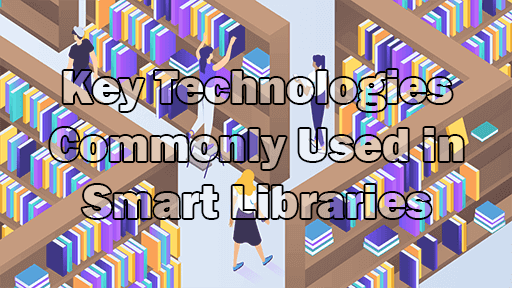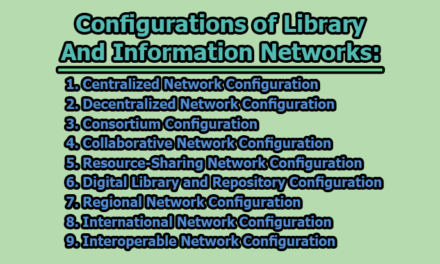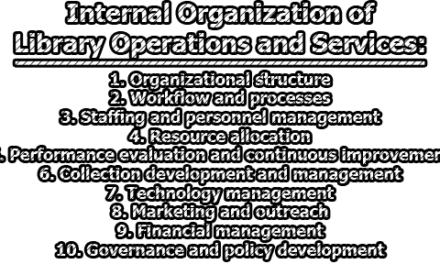Key Technologies Commonly Used in Smart Libraries:
The advent of smart libraries marks a paradigm shift in the way traditional knowledge repositories operate, seamlessly blending conventional library services with cutting-edge technologies. Smart libraries stand as beacons of innovation, utilizing a diverse range of technological advancements to redefine the landscape of information access, management, and sharing. From RFID systems streamlining inventory management to digital catalogs offering remote access to vast collections, these institutions epitomize the fusion of digital prowess with the timeless mission of fostering learning and community engagement. In this comprehensive exploration, we will explore the key technologies commonly used in smart libraries.
1. RFID Technology (Revolutionizing Inventory Management and Patron Services): Radio Frequency Identification (RFID) technology stands as a cornerstone in the transformation of traditional libraries into smart libraries. It introduces a seamless and efficient approach to the management and tracking of library materials. Each item within the library’s extensive collection is affixed with a small RFID tag, housing a unique identifier. This tag facilitates automated identification and tracking through RFID readers strategically placed within the library.
The primary advantage of RFID lies in its ability to eliminate the need for manual barcode scanning during the borrowing process. When patrons check out items, RFID readers detect the tags, instantly updating the library’s database to reflect the transaction in real-time. This not only expedites the borrowing process but also minimizes wait times, contributing to an overall enhancement of operational efficiency.
Moreover, RFID technology empowers patrons through self-service operations. RFID-enabled kiosks within the library provide a user-friendly interface, guiding users through the borrowing process independently. This not only reduces the workload on library staff but also provides patrons with a more streamlined and convenient borrowing experience.
The implementation of RFID in smart libraries extends beyond traditional inventory management. It optimizes the overall library experience, reducing human error, and empowering patrons with self-service capabilities. In essence, RFID technology serves as the backbone of efficient and user-friendly library operations, epitomizing the fusion of technological innovation and traditional library services.
2. Digital Catalogs and Databases (Gateway to Seamless Resource Access): Digital catalogs and databases represent a transformative shift in how patrons access and interact with library resources. These platforms serve as centralized repositories, transcending the limitations of physical library visits and enabling patrons to engage with library materials remotely.
One of the key features of digital catalogs is their advanced search functionalities. Users can efficiently search, browse, and access a wide array of materials using criteria such as author, title, subject, and format. This not only simplifies resource discovery but also caters to diverse user preferences, ensuring a personalized experience.
Personalization is further enhanced through sophisticated recommendation algorithms embedded in digital catalogs. These algorithms analyze user preferences and borrowing history, suggesting tailored reading materials to patrons. This personalized touch not only fosters a deeper connection between patrons and the library but also increases the likelihood of patrons discovering resources aligned with their interests.
Digital catalogs also facilitate the borrowing of digital materials, including e-books and audiobooks, without requiring patrons to physically visit the library. This remote access aligns with the evolving needs and preferences of modern patrons, contributing to the overall accessibility and inclusivity of smart libraries.
Consequently, digital catalogs and databases serve as the gateway to a vast and diverse collection of resources, providing patrons with a seamless and personalized experience that goes beyond the confines of traditional library services.
3. Digital Lending Platforms (Navigating the Digital Revolution in Library Services): As the world undergoes a digital revolution, smart libraries are adapting to meet the changing preferences of patrons through the implementation of digital lending platforms. These platforms serve as a bridge between traditional library services and the digital age, offering patrons the ability to borrow e-books, audiobooks, and other digital materials remotely.
Digital lending platforms provide a diverse range of digital content that patrons can access and download to their devices, eliminating the need for physical copies. This not only aligns with the preferences of patrons who prefer digital formats but also caters to those facing mobility constraints that hinder in-person library visits.
One of the key strengths of digital lending platforms lies in their support for various lending models. These platforms accommodate simultaneous access licenses and metered access, ensuring flexibility in meeting diverse demand and usage patterns. The adaptability of these platforms reflects a commitment to providing patrons with choices that align with their preferences.
Furthermore, the integration of digital lending platforms into the library ecosystem extends the reach of resources beyond the physical confines of the library. Patrons can borrow digital materials without being constrained by geographical distances, thus enhancing the library’s accessibility and relevance in the digital age.
Thus, digital lending platforms serve as a response to the digital revolution, expanding the library’s offerings to cater to the evolving needs and preferences of patrons in an increasingly digitalized world.
4. Mobile Applications (Empowering Patrons Anytime, Anywhere): In the era of smartphones and tablets, smart libraries leverage dedicated mobile applications to enhance accessibility and patron engagement. These mobile apps serve as portable gateways to library services, enabling patrons to access catalogs, reserve materials, and manage their accounts seamlessly from their handheld devices.
The user experience on mobile applications is optimized for touchscreen interactions, ensuring an intuitive and user-friendly interface. Patrons can navigate through catalogs, explore resources, and perform various library-related tasks with ease, all from the convenience of their smartphones or tablets. This not only enhances user experience but also aligns with the modern lifestyle where individuals seek convenience and flexibility in accessing services.
Push notifications play a crucial role in keeping patrons informed and engaged. Mobile apps can notify patrons about upcoming events, new arrivals, and overdue items, fostering ongoing engagement with the library. This feature not only enhances communication between the library and its patrons but also ensures that users stay informed about relevant updates.
Additionally, mobile applications support integration with other digital services, such as e-book platforms and audiobook providers. This integration consolidates diverse resources into a single interface, providing patrons with a comprehensive and unified platform for accessing a wide range of materials.
Therefore, mobile applications empower patrons to connect with library services anytime, anywhere, catering to the mobile-centric lifestyles of modern users and ensuring that the library remains an integral part of their daily lives.
5. Data Analytics and Machine Learning (Shaping Intelligent Library Services): In the realm of smart libraries, data analytics and machine learning emerge as powerful tools shaping intelligent and user-centric services. These technologies enable libraries to analyze vast amounts of data, gaining valuable insights into user behavior, preferences, and overall usage patterns. By leveraging these insights, smart libraries can make data-driven decisions to enhance operations and continually improve the user experience.
Data analytics plays a pivotal role in optimizing collection development. Machine learning algorithms analyze circulation data to identify popular genres, authors, and subjects. This information aids libraries in making informed decisions about acquiring and promoting materials that align with patron preferences, thereby ensuring a relevant and engaging collection.
Predictive analytics further enhance the proactive management of library resources. By forecasting demand based on historical borrowing patterns, libraries can anticipate which materials will be in high demand, allowing for strategic acquisitions and promotions. This forward-looking approach enables libraries to stay ahead of patron needs, ensuring that popular materials are readily available.
Machine learning algorithms also contribute to personalized user experiences. By analyzing individual patrons’ past interactions and preferences, libraries can recommend relevant materials, creating a tailored and engaging browsing experience. This personalization fosters a deeper connection between patrons and the library, increasing overall satisfaction and encouraging continued engagement.
Subsequently, data analytics and machine learning empower smart libraries to evolve and adapt to the dynamic needs of patrons. These technologies enable libraries to stay ahead of trends, make informed decisions, and provide personalized services that enhance the overall library experience.
6. Internet of Things (IoT) Devices (Creating Intelligent Library Environments): The integration of Internet of Things (IoT) devices within smart libraries ushers in a new era of intelligent and responsive environments. IoT sensors and beacons strategically deployed throughout library facilities provide real-time data on various parameters, including occupancy levels, temperature, humidity, and environmental conditions.
Occupancy sensors play a crucial role in optimizing space utilization. By monitoring the usage of study rooms, meeting spaces, and other facilities, libraries can allocate resources more efficiently and provide timely assistance to patrons. This data-driven approach enhances the overall efficiency of library operations, ensuring that spaces are utilized to their full potential.
Environmental sensors contribute to the preservation of library materials and equipment. By monitoring temperature and humidity levels, libraries can create optimal conditions for preserving the integrity of physical collections. This proactive approach to environmental management ensures the longevity of materials and contributes to sustainable library practices.
IoT devices also extend to smart lighting and climate control systems within library facilities. These systems automatically adjust settings based on occupancy and environmental conditions, contributing to energy efficiency and sustainability. By minimizing energy consumption when spaces are unoccupied, libraries reduce their ecological footprint while providing a comfortable environment for patrons.
Hence, IoT devices create intelligent and adaptive library environments. By harnessing real-time data, smart libraries ensure that spaces are efficiently utilized, resources are optimally managed, and environmental conditions are conducive to both patron comfort and the preservation of library materials.
7. Interactive Displays and Virtual Reality (VR) (Immersive Learning Experiences): Smart libraries enrich patron experiences by incorporating interactive displays and virtual reality (VR) technologies. Interactive displays serve as dynamic platforms that provide engaging and interactive content, fostering exploration and learning for users of all ages. These displays can showcase digital exhibits, educational videos, and interactive tutorials on a wide range of topics, sparking curiosity and inspiring discovery.
The collaborative capabilities of interactive displays contribute to community engagement within the library. Users can participate in group discussions, collaborative activities, and interactive presentations, creating a sense of community and collaboration. This communal aspect of interactive displays aligns with the evolving role of libraries as hubs for social interaction and knowledge sharing.
Virtual reality (VR) technology takes the immersive experience to the next level by transporting users to virtual environments and simulations. Smart libraries leverage VR to offer virtual tours of historical landmarks, immersive experiences in STEM fields, and interactive storytelling initiatives that bring literature to life. This immersive approach to learning enhances patron engagement, making the library a dynamic and exciting space for exploration.
Moreover, interactive displays and VR technologies cater to diverse learning styles, providing an inclusive and accessible learning environment within the library. These technologies bridge the gap between traditional and digital learning methods, ensuring that patrons have access to innovative and enriching experiences.
Consequently, the integration of interactive displays and VR technologies transforms smart libraries into hubs of immersive learning. These technologies inspire curiosity, foster collaboration, and provide patrons with dynamic opportunities for exploration and discovery.
8. Self-Service Kiosks and Automated Systems (Empowering Patrons with Efficiency): Self-service kiosks and automated systems play a pivotal role in smart libraries, empowering patrons with the efficiency of performing various tasks independently. These systems streamline routine operations, reducing wait times and allowing library staff to focus on providing personalized assistance and expertise.
Self-service kiosks feature intuitive touchscreen interfaces that guide patrons through the borrowing process. From checking out materials to paying fines and renewing library cards, patrons can complete these tasks with ease and speed, minimizing the need for staff intervention. The user-friendly design of these kiosks ensures inclusivity, supporting multiple languages and incorporating accessibility features.
Beyond patron-facing interactions, automated systems enhance overall library efficiency. Tasks such as sorting returned materials, replenishing inventory, and generating reports are automated, freeing up staff from repetitive tasks and allowing them to focus on more complex and value-added responsibilities. This shift in task distribution improves staff productivity and enhances the overall quality of library services.
The implementation of self-service kiosks and automated systems aligns with the modern patron’s desire for convenience and autonomy. Patrons appreciate the quick and hassle-free experience facilitated by these technologies, contributing to a positive perception of the library as an accessible and user-friendly institution.
Thus, self-service kiosks and automated systems empower patrons and streamline library operations, ensuring that smart libraries offer efficient and user-centric services in a rapidly evolving technological landscape.
9. Artificial Intelligence (AI) in Smart Libraries (Enhancing Decision-Making and User Interaction): Artificial Intelligence (AI) plays a significant role in advancing the capabilities of smart libraries. Through AI applications, libraries can enhance decision-making processes, automate repetitive tasks, and provide personalized user interactions. AI algorithms can analyze large datasets to identify trends, helping libraries make informed decisions about resource acquisition, service improvement, and community engagement initiatives. Additionally, AI-powered chatbots can offer real-time assistance to patrons, answering queries, guiding navigation, and providing a more interactive and responsive library experience.
AI also contributes to content recommendation systems, suggesting relevant materials based on user preferences, search history, and borrowing patterns. This personalization not only enhances user satisfaction but also encourages patrons to explore diverse resources within the library’s collection. Smart libraries leverage AI-driven insights to continuously improve their services, ensuring they remain dynamic and aligned with the evolving needs of their communities.
10. Cloud Computing (Facilitating Remote Access and Collaborative Services): The adoption of cloud computing technology is pivotal in transforming smart libraries into agile and accessible information hubs. Cloud-based systems facilitate remote access to digital catalogs, databases, and resources, enabling patrons to engage with library materials from virtually anywhere. This remote accessibility aligns with the contemporary lifestyle where users expect on-the-go access to information.
Moreover, cloud computing enables collaborative services and resource sharing among libraries. Libraries can leverage cloud-based platforms to share digital collections, collaborate on joint initiatives, and enhance the overall reach of resources. This collaborative approach ensures that libraries can collectively address the diverse needs of their communities while optimizing resource allocation.
The scalability and flexibility of cloud computing empower smart libraries to adapt to changing technological landscapes, ensuring they can efficiently manage and expand their digital collections without the constraints of physical infrastructure.
11. Cybersecurity Measures in Smart Libraries (Safeguarding Patron Data and Library Resources): As smart libraries increasingly digitize their operations and collections, ensuring the security of patron data and library resources becomes paramount. Robust cybersecurity measures are implemented to safeguard against potential threats, including data breaches, unauthorized access, and other cyber-attacks.
Encryption technologies are employed to protect sensitive patron information, ensuring that personal data and borrowing histories remain confidential. Multi-factor authentication adds an extra layer of security to patron accounts, reducing the risk of unauthorized access.
Library management systems are fortified with cybersecurity protocols to prevent data manipulation or loss. Regular security audits and updates are conducted to stay ahead of emerging threats and vulnerabilities, maintaining a secure digital environment for both patrons and library staff.
By prioritizing cybersecurity, smart libraries demonstrate their commitment to patron privacy, data integrity, and the overall trustworthiness of digital library services.
12. Augmented Reality (AR) (Enriching Physical Spaces with Interactive Elements): Smart libraries leverage Augmented Reality (AR) to enhance physical spaces with interactive elements, creating a seamless blend of the digital and physical realms. AR applications, accessed through smartphones or AR glasses, provide patrons with additional information, interactive exhibits, and immersive experiences as they navigate the library.
For example, AR can be used to overlay digital information on physical books, offering additional details about the author, related materials, or even interactive multimedia content. This immersive approach not only enriches the patron experience but also promotes exploration and discovery within the library’s physical collection.
Furthermore, AR can be integrated into educational programs and workshops, allowing patrons to engage with AR-enhanced content during library events. This technology-driven approach aligns with the educational objectives of smart libraries, making learning more interactive and accessible.
13. Blockchain Technology (Enhancing Security and Transparency in Transactions): Blockchain technology finds application in smart libraries to enhance security and transparency, particularly in transactions related to digital resources and services. Blockchain provides a decentralized and secure ledger system that records and verifies transactions without the need for intermediaries.
In the context of smart libraries, blockchain ensures the integrity of digital lending transactions. Each borrowing or return action is securely recorded on the blockchain, providing an immutable record of the transaction history. This not only enhances the security of digital lending platforms but also ensures transparency and trust between the library and its patrons.
Moreover, blockchain can be employed in the management of digital rights and licensing for electronic resources. Smart contracts on the blockchain automatically enforce licensing agreements, ensuring that digital materials are accessed within the bounds of copyright and licensing terms.
By integrating blockchain technology, smart libraries not only bolster the security of their digital transactions but also contribute to a more transparent and accountable system for managing digital resources.
14. 3D Printing and Makerspaces (Fostering Creativity and Innovation): Smart libraries embrace 3D printing technology and makerspaces to foster creativity and innovation within their communities. Makerspaces are collaborative environments equipped with tools, technology, and resources that enable patrons to engage in hands-on, DIY projects.
Libraries equipped with 3D printers allow patrons to bring their digital designs to life, promoting innovation in fields such as STEM education, prototyping, and artistic expression. Makerspaces serve as hubs for collaborative learning, enabling patrons to share knowledge, skills, and ideas while utilizing cutting-edge technologies.
The integration of 3D printing and makerspaces expands the traditional role of libraries beyond information consumption to actively supporting patrons in the creation of tangible, real-world objects. This dynamic and participatory approach aligns with the evolving nature of libraries as community hubs for creativity and skill development.
15. Open Access Initiatives and Institutional Repositories (Expanding Knowledge Accessibility): Smart libraries actively contribute to the global open access movement by establishing institutional repositories and supporting open access initiatives. Institutional repositories serve as platforms for the storage and dissemination of scholarly and research materials produced by the academic and research communities associated with the library.
By providing open access to a wide range of academic resources, including research papers, theses, and datasets, smart libraries contribute to the democratization of knowledge. Patrons, researchers, and the broader community can freely access and engage with valuable academic content, fostering collaboration and knowledge dissemination.
Open access initiatives align with the mission of smart libraries to broaden information accessibility, promote research dissemination, and support the principles of scholarly communication. The implementation of institutional repositories underscores the role of smart libraries as key players in advancing open access and making scholarly content readily available to a global audience.
In conclusion, the integration of a diverse array of cutting-edge technologies has transformed traditional libraries into smart libraries, marking a revolutionary evolution in the way information is accessed, managed, and shared. From RFID technology streamlining inventory processes to the immersive experiences offered through interactive displays and virtual reality, these technological marvels have redefined the library experience. The convergence of digital catalogs, mobile applications, data analytics, and self-service kiosks has not only optimized operational efficiency but has also empowered patrons with greater accessibility and personalized services. Smart libraries stand as dynamic hubs of innovation, embracing artificial intelligence, cloud computing, augmented reality, and blockchain to stay at the forefront of technological advancements. As smart libraries continue to adapt and innovate, their commitment to fostering inclusivity, engagement, and lifelong learning positions them as vital pillars in the ever-evolving landscape of knowledge dissemination and community enrichment.
You may also read the following article: Smart Library | Definition and Four dimensions of the smart library

Former Student at Rajshahi University










